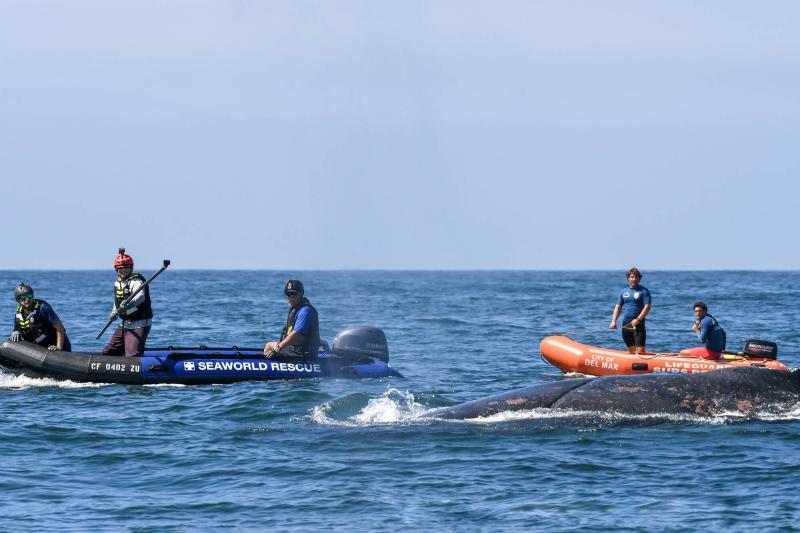
Team frees entangled humpback whale off Southern California Coast
by NOAA Fisheries 9 Oct 2022 16:08 UTC

A team from NOAA Fisheries and SeaWorld prepares to use a specialized knife on a long pole to cut an entangled humpback whale loose from crab fishing gear on September 26, 2002 © SeaWorld San Diego / MMHSRP Permit #18786-06
A trained team from NOAA Fisheries and SeaWorld freed a humpback whale off the coast of San Diego on Monday. It was entangled in more than 300 feet of lines and crab fishing gear.
A local boater reported the whale entangled in line and buoys and struggling to swim on Sunday, September 25. A team from SeaWorld later located the whale and documented the entanglement, which was critical to helping responders plan for the following day.
On Monday, September 26, two NOAA Fisheries responders joined the SeaWorld team. Local lifeguards, harbor patrol officers, and state park staff helped locate the whale off San Elijo State Beach. The team positioned an underwater camera on a long extendable carbon-fiber pole near the whale to examine the entangling lines and identify a suitable location to cut the lines. They then used a specially designed knife at the end of a pole to cut the line, freeing the whale. It had been entangled in more than 300 feet of lines and five buoys.
"There was deeply embedded line and a lot of gear trailing on the whale's right side; I was not sure what we would be able to do for the whale," said Justin Viezbicke, California Marine Mammal Stranding Coordinator with NOAA Fisheries. "We were fortunate that the camera helped us see one spot that looked like it would let us cut all the lines off at once."
"The gear was identified as Dungeness crab fishing gear from Oregon, highlighting the long distances that whales can swim with life-threatening entanglements," he said. While the whale is now gear free, the lines cut deep wounds into its flesh. Biologists are cautiously optimistic that the wounds will heal and the whale will survive.
Of the 27 whales confirmed entangled off the West Coast in 2021, humpback whales were the most common species. Teams responded in 19 cases, and in seven instances removed at least some of the entangling gear. Removing (or even partially removing) entangling material from an animal increases the likelihood of that animal surviving. Data gathered through entanglement response activities can highlight which types of fishing gear or debris pose the greatest threat to marine mammals, and which species are most susceptible. NOAA Fisheries' West Coast Region has helped train teams along the West Coast to respond to entanglements.
Responders praised the local boater for providing information about the entanglement while staying a safe and legal distance from the whale. They said teamwork by the West Coast Marine Mammal Stranding Network and support from local authorities contributed to the successful effort to disentangle the whale.
Only trained and authorized teams should approach entangled whales. When well-intentioned members of the public try to save a whale on their own, they put themselves and the animals in grave danger. The best way to help is by reporting sightings of entangled whales to the local entanglement response network. Then, stand by until response team members arrive, and provide any photos or videos to NOAA Fisheries. If you see an entangled whale, stay a safe distance away while gathering photos and other information to help responders. To report entangled marine mammals, please call (877) SOS-WHALE/ (877) 767-9425 or call the U.S. Coast Guard on Channel 16.